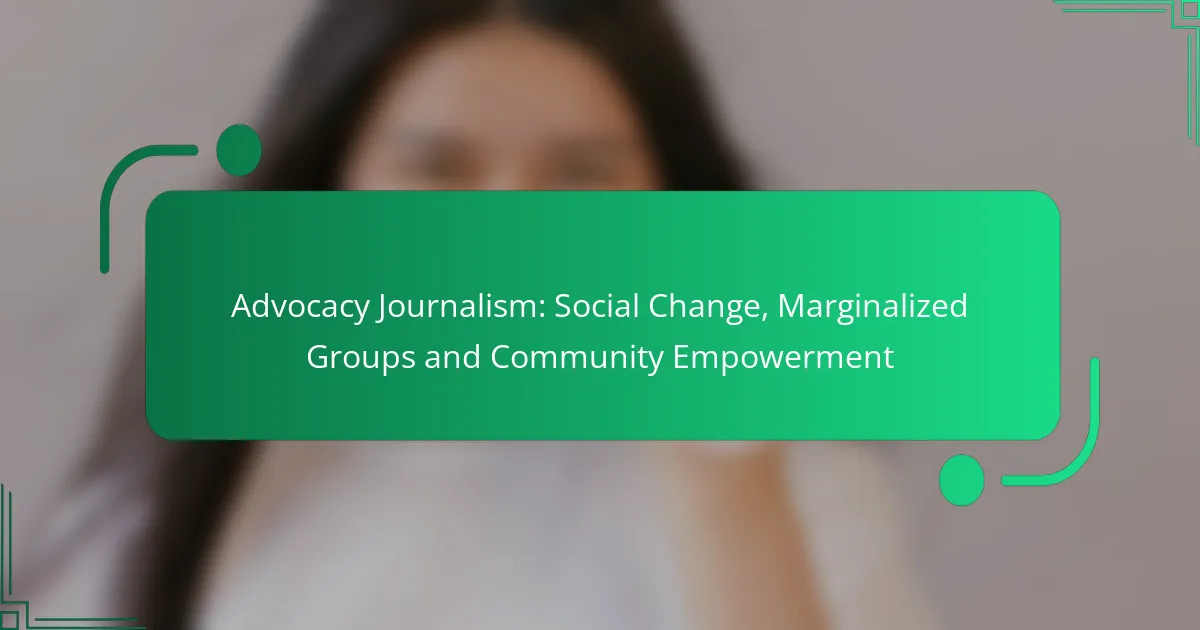Advocacy journalism plays a crucial role in driving social change by focusing on the challenges faced by marginalized communities and amplifying their voices. By informing the public and influencing decision-makers, it fosters a more equitable society and empowers these communities to advocate for their rights and needs.
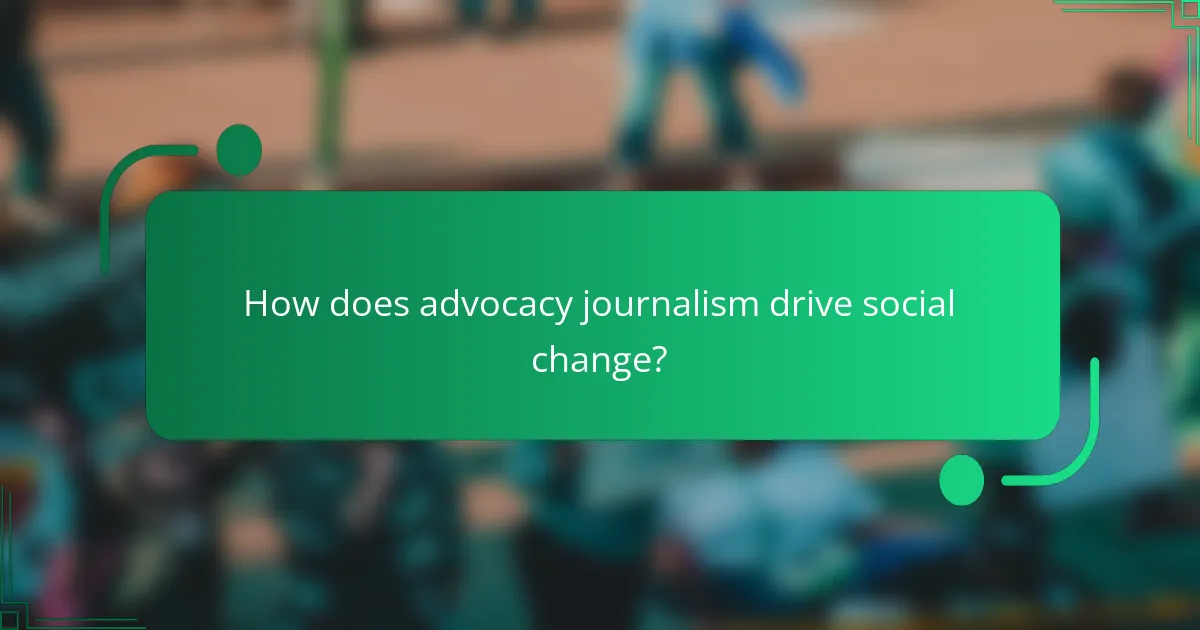
How does advocacy journalism drive social change?
Advocacy journalism drives social change by highlighting issues affecting marginalized communities and promoting their voices. It aims to inform the public and influence decision-makers, ultimately fostering a more equitable society.
Empowers marginalized voices
Advocacy journalism plays a crucial role in empowering marginalized voices by providing a platform for those often overlooked by mainstream media. By sharing personal stories and experiences, it amplifies the concerns of underrepresented groups, fostering understanding and empathy among the broader public.
For instance, journalists may focus on the struggles of immigrant communities, shedding light on their challenges and contributions. This not only raises awareness but also encourages community engagement and solidarity.
Influences public policy
Advocacy journalism influences public policy by bringing attention to specific issues that require legislative action. By investigating and reporting on systemic injustices, journalists can inform policymakers and the public about the need for change.
For example, coverage of housing inequalities can lead to policy discussions about affordable housing initiatives. Effective advocacy journalism often includes calls to action, urging readers to support specific reforms or engage with their representatives.
Raises awareness on critical issues
Raising awareness on critical issues is a fundamental aspect of advocacy journalism. By focusing on topics such as climate change, racial injustice, or healthcare disparities, journalists can educate the public and spark necessary conversations.
Utilizing various media formats, including articles, podcasts, and documentaries, advocacy journalism can reach diverse audiences. This multifaceted approach helps ensure that important issues remain in the public consciousness, prompting community action and dialogue.
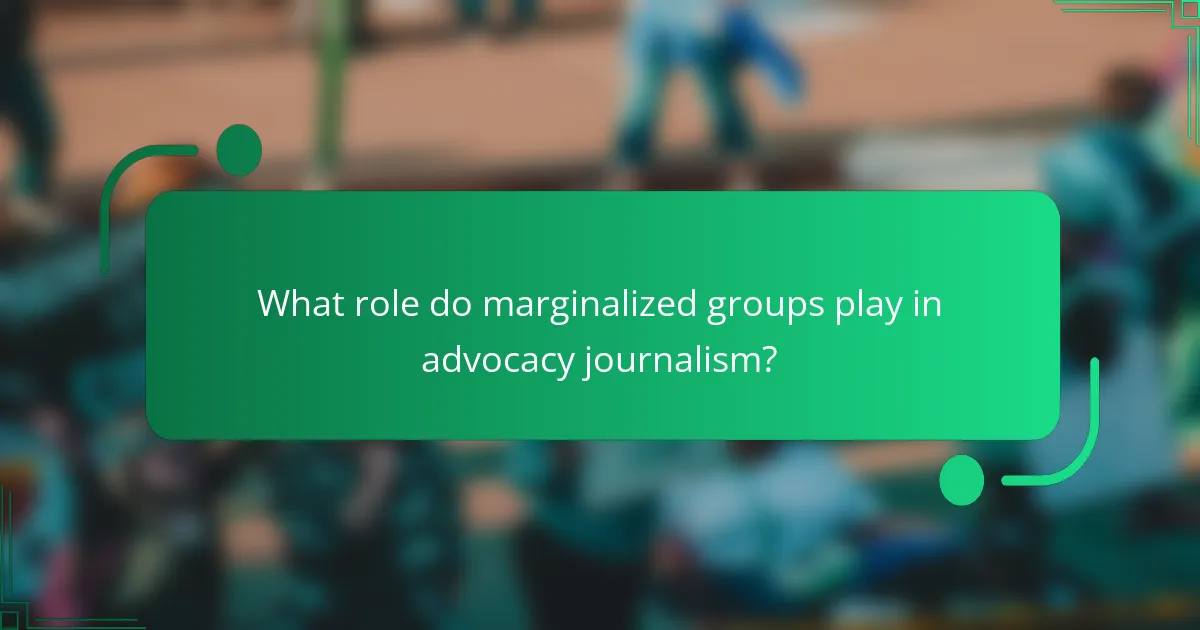
What role do marginalized groups play in advocacy journalism?
Marginalized groups are central to advocacy journalism as they provide essential perspectives and narratives that challenge dominant societal views. Their involvement ensures that diverse voices are heard, fostering social change and community empowerment.
Representation in media narratives
Representation in media narratives is crucial for accurately reflecting the experiences of marginalized groups. When these communities are portrayed authentically, it helps to dismantle stereotypes and promotes understanding among broader audiences. Advocacy journalism seeks to amplify these voices, ensuring that their stories are not only told but also respected.
For instance, media outlets that prioritize diverse representation can influence public opinion and policy by showcasing the challenges faced by marginalized communities. This can lead to increased awareness and support for social justice initiatives, ultimately contributing to systemic change.
Community-led storytelling
Community-led storytelling empowers marginalized groups to share their own narratives, fostering a sense of ownership and agency. This approach allows individuals to articulate their experiences in their own words, which can be more impactful than external interpretations. Advocacy journalism often collaborates with these communities to facilitate platforms for their stories.
Examples of community-led storytelling include local initiatives where residents document their experiences through various media, such as blogs, podcasts, or video projects. These efforts not only highlight specific issues but also build solidarity within the community, encouraging collective action and advocacy for change.

How can advocacy journalism empower communities?
Advocacy journalism empowers communities by amplifying the voices of marginalized groups and highlighting social issues that affect them. This form of journalism fosters awareness and drives action, enabling communities to advocate for their rights and needs.
Facilitates grassroots movements
Advocacy journalism plays a crucial role in facilitating grassroots movements by providing a platform for local voices and stories. By covering issues that resonate with community members, journalists can inspire collective action and mobilize support for various causes.
For example, a local news outlet might report on environmental concerns affecting a neighborhood, prompting residents to organize clean-up events or lobby for policy changes. This type of coverage not only raises awareness but also encourages individuals to take ownership of their community’s challenges.
Encourages civic engagement
Advocacy journalism encourages civic engagement by informing citizens about their rights and responsibilities. By reporting on local governance, social justice issues, and community resources, journalists can motivate individuals to participate in civic activities such as voting, attending town hall meetings, or joining advocacy groups.
Moreover, effective advocacy journalism often includes calls to action, providing readers with clear steps they can take to get involved. For instance, articles may list upcoming events, provide contact information for local representatives, or outline ways to support specific initiatives, thus fostering a more engaged and informed citizenry.

What are the best practices for advocacy journalists?
Advocacy journalists should prioritize transparency, community engagement, and ethical standards to effectively promote social change and empower marginalized groups. By adhering to best practices, they can build credibility and foster meaningful connections with the communities they serve.
Building trust with communities
Building trust with communities is essential for advocacy journalists. This involves actively listening to community members and understanding their needs, concerns, and aspirations. Engaging in open dialogues can help establish a rapport and create a sense of partnership.
Journalists should consider attending community meetings or events to immerse themselves in the local culture and issues. Sharing stories that reflect the voices of community members can also enhance trust, as it demonstrates a commitment to accurately representing their experiences and perspectives.
Ensuring ethical reporting
Ensuring ethical reporting is crucial for advocacy journalists to maintain credibility and uphold journalistic integrity. This includes verifying facts, avoiding conflicts of interest, and respecting the privacy and dignity of individuals involved in stories. Adhering to established ethical guidelines, such as those from the Society of Professional Journalists, can provide a solid framework.
Additionally, journalists should be transparent about their intentions and the potential impact of their work. It is important to obtain informed consent from individuals before sharing their stories, especially when dealing with vulnerable populations. Regularly reflecting on the ethical implications of their reporting can help journalists navigate complex situations responsibly.

What challenges do advocacy journalists face?
Advocacy journalists encounter several significant challenges that can hinder their ability to promote social change and empower marginalized groups. These challenges include limited access to resources and the risk of censorship, both of which can impact the effectiveness and reach of their work.
Access to resources
Access to resources is a critical challenge for advocacy journalists, as they often operate with limited funding and support. Many rely on grants, donations, or crowdfunding, which can be unpredictable and insufficient for comprehensive reporting.
Additionally, they may lack access to essential tools such as advanced technology, research databases, or professional training. This can restrict their ability to gather information, conduct interviews, and produce high-quality content that resonates with their audience.
Risk of censorship
The risk of censorship poses a significant threat to advocacy journalists, particularly when covering sensitive topics or challenging powerful entities. Governments, corporations, or other influential groups may attempt to suppress information or intimidate journalists to prevent the dissemination of critical narratives.
To navigate this risk, advocacy journalists must be aware of local laws and regulations regarding press freedom. They should also consider using secure communication methods and platforms that protect their sources and content from potential censorship.
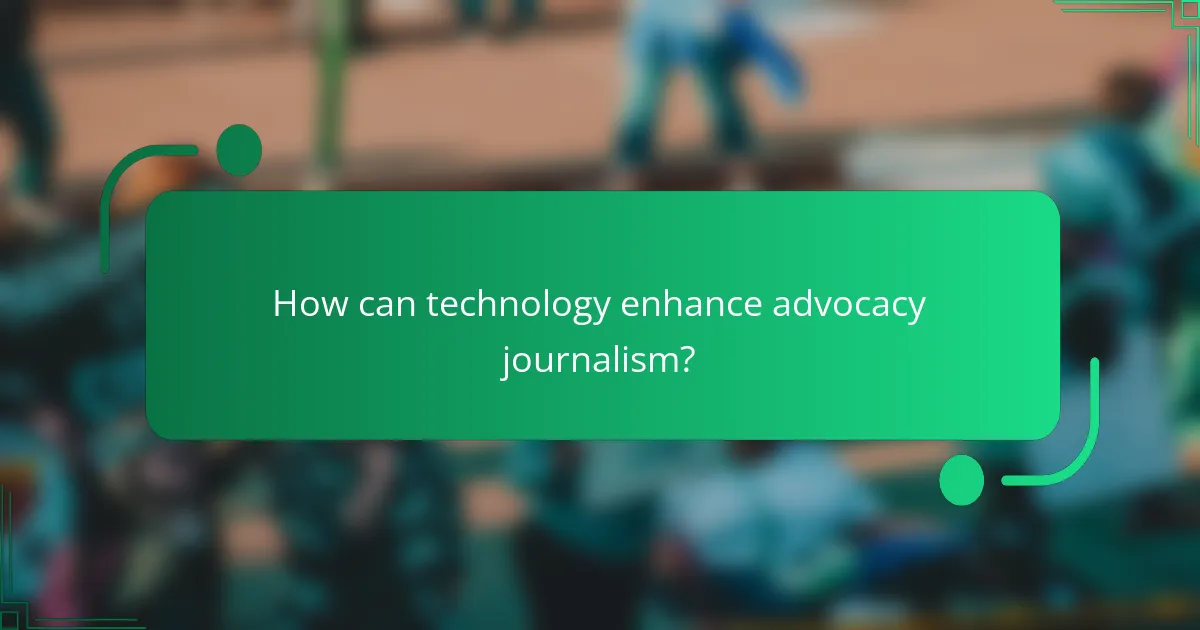
How can technology enhance advocacy journalism?
Technology enhances advocacy journalism by providing tools that amplify voices, increase accessibility, and facilitate data-driven storytelling. Through various digital platforms, journalists can reach wider audiences and engage communities in meaningful ways.
Utilizing social media platforms
Social media platforms serve as powerful tools for advocacy journalism by enabling real-time communication and audience engagement. Journalists can share stories, gather feedback, and mobilize support for marginalized groups quickly and effectively.
To maximize impact, journalists should focus on platforms where their target audience is most active, such as Twitter for breaking news or Instagram for visual storytelling. Regularly engaging with followers through comments and live sessions can foster a sense of community and encourage participation.
Data journalism for impact
Data journalism plays a crucial role in advocacy by providing evidence-based narratives that highlight social issues affecting marginalized communities. By analyzing data sets, journalists can uncover trends, disparities, and injustices that may otherwise go unnoticed.
When utilizing data, it’s essential to ensure accuracy and clarity. Journalists should use visualizations like charts and infographics to make complex information more digestible. Collaborating with data scientists or using user-friendly tools can enhance the quality of the analysis and presentation.
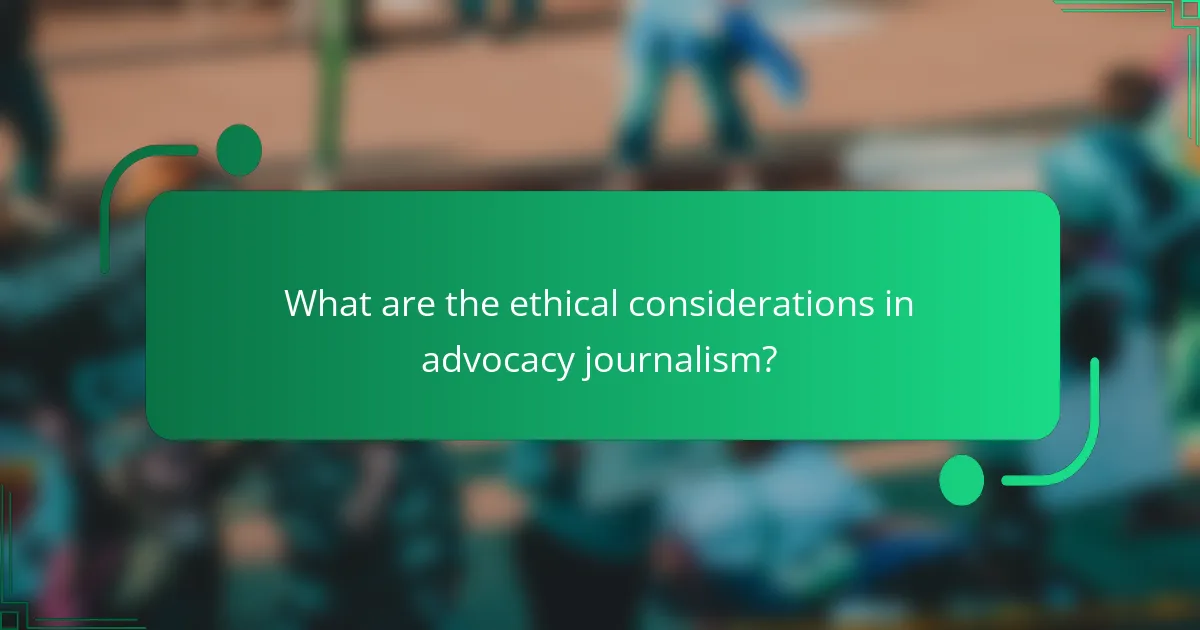
What are the ethical considerations in advocacy journalism?
Ethical considerations in advocacy journalism revolve around balancing the promotion of social change with the responsibility to report truthfully and fairly. Journalists must navigate the complexities of bias, source protection, and the potential impact of their work on marginalized communities.
Maintaining objectivity
Maintaining objectivity is crucial for advocacy journalists to ensure credibility and trust. While advocating for a cause, it’s essential to present facts accurately and avoid letting personal beliefs overshadow the reporting. This can involve cross-checking information with multiple sources and providing context to the issues at hand.
One effective strategy is to differentiate between advocacy pieces and traditional news reporting. Clearly labeling opinion pieces can help audiences understand the intent behind the content, allowing them to critically evaluate the information presented.
Protecting sources
Protecting sources is a fundamental ethical obligation in journalism, especially when dealing with marginalized groups. Advocacy journalists must ensure that the identities of their sources are safeguarded, particularly if revealing them could lead to harm or discrimination. This can involve using anonymous quotes or pseudonyms when necessary.
Additionally, journalists should be transparent with sources about how their information will be used and the potential risks involved. Establishing trust and clear communication can help empower sources to share their stories while minimizing their exposure to danger.

How does advocacy journalism differ from traditional journalism?
Advocacy journalism actively promotes a specific cause or viewpoint, contrasting with traditional journalism’s objective reporting. While traditional journalists strive for neutrality, advocacy journalists aim to influence public opinion and drive social change.
Focus on social justice
Advocacy journalism emphasizes social justice by highlighting issues faced by marginalized groups. This approach seeks to amplify voices that are often overlooked, such as those of the economically disadvantaged, racial minorities, or individuals with disabilities.
By focusing on social justice, advocacy journalists often engage in storytelling that reveals systemic injustices and encourages community action. For example, a piece on housing inequality might not only report facts but also include personal narratives from affected families to illustrate the human impact of policies.
Empowerment of marginalized communities
Empowerment is a core principle of advocacy journalism, aiming to give marginalized communities a platform to express their experiences and needs. This can involve collaborating with community members to ensure their perspectives are accurately represented and prioritized.
For instance, advocacy journalists may conduct workshops to train community members in storytelling and media skills, enabling them to share their own stories. This participatory approach fosters a sense of ownership and agency among those who are often depicted as passive subjects in traditional media.
Engagement with activism
Advocacy journalism frequently intersects with activism, as journalists may participate in or promote campaigns that align with their causes. This engagement can enhance the impact of their reporting by mobilizing public support and encouraging direct action.
However, journalists must navigate the fine line between reporting and activism. Maintaining credibility requires transparency about their involvement in advocacy efforts, ensuring that their reporting remains grounded in factual accuracy while still promoting social change.
